Nail Abnormalities: What to Know
Medically reviewed by Susan Bard, MD
Nail abnormalities are indicated by changes in the shape, color, thickness, and texture of the fingernails, toenails, or both. Some changes are normal and harmless, while others may be a sign of injury, infection, or a health condition that requires medical attention.
Since nails can be an outward reflection of our health, it’s important to watch for nail changes, like dents or ridges. You may be able to prevent some nail abnormalities with nail hygiene and adequate nutrition.
This article discusses common nail abnormalities, their causes, and when to consult a healthcare provider.
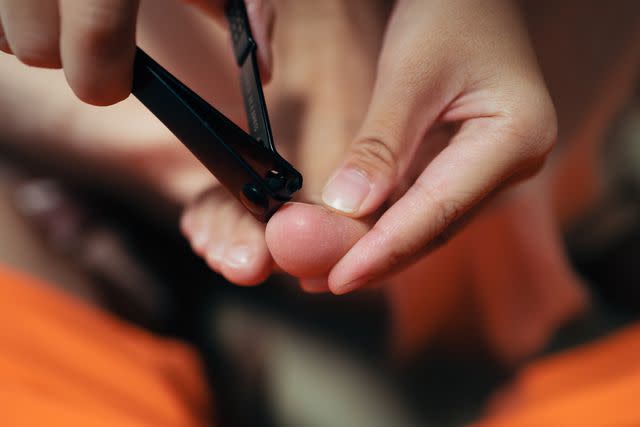
What Are Nail Abnormalities and What Causes Them?
How your nails look can reflect your health. Healthy nails are the same color throughout (no spots or discoloration) and are smooth on the surface (no grooves or pitting).
Changes in nail shape, color, thickness, and texture indicate a variety of nail abnormalities. Nail abnormalities can occur on both the fingernails and toenails. Some of these changes may be natural and normal, while others may be a sign of an underlying health condition.
Unhealthy nails may show the following signs and symptoms, described in more detail below:
Dents
Discoloration or spots
Nail separation
Ridges
Nail abnormalities can be caused by harmless things, such as minor injury, or concerning things, such as nutritional deficiencies and underlying systemic diseases. For example, brittle nails are often a normal sign of aging.
It’s always best to consult a healthcare provider if you’re concerned about nail changes so that they can make an accurate diagnosis and treatment plan. Below are some nail abnormalities to watch out for and their related causes.
Beau's Lines
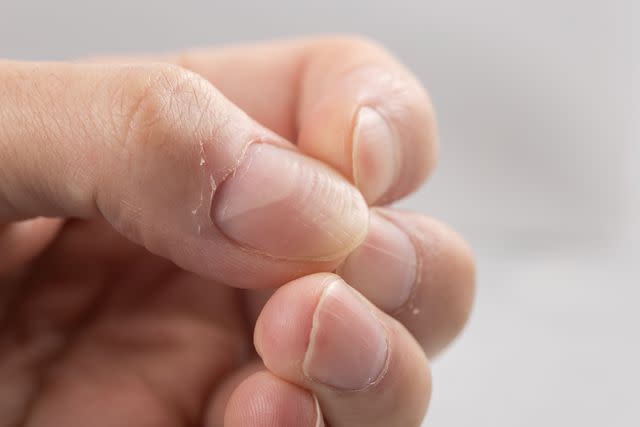
Dmytro Skrypnykov / Getty Images
Beau’s lines, also called Beau lines, are horizontal ridges or indentations on the fingernails. These lines that run the width of the nail indicate that something stopped or slowed the growth of your nail for some time.
Beau’s lines may occur for a variety of reasons, including:
Illness
Injury to the nail
Chemotherapy
Malnutrition
Fever
Significant stress
Once the cause is addressed with help from a healthcare provider, the nail should start growing normally again.
Clubbing
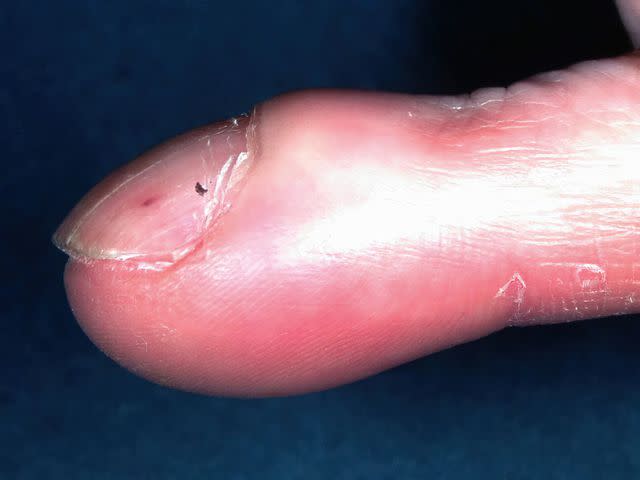
Reproduced with permission from © DermNet dermnetnz.org 2023
Nail clubbing is when the fingernails or toenails are curved downward, like the back of a spoon. The curving of the nails usually happens gradually and can go unnoticed for a while. When nail clubbing occurs, the fingernails often feel spongelike when you press them, and the fingertips look swollen.
Nail clubbing may be a harmless trait that runs in the family. Other times, it can indicate a medical condition of the heart, lungs, liver, intestine, or stomach. It warrants a visit to a healthcare provider such as a dermatologist (medical specialist in conditions of the nails, skin, and hair).
Koilonychia (Spooning)
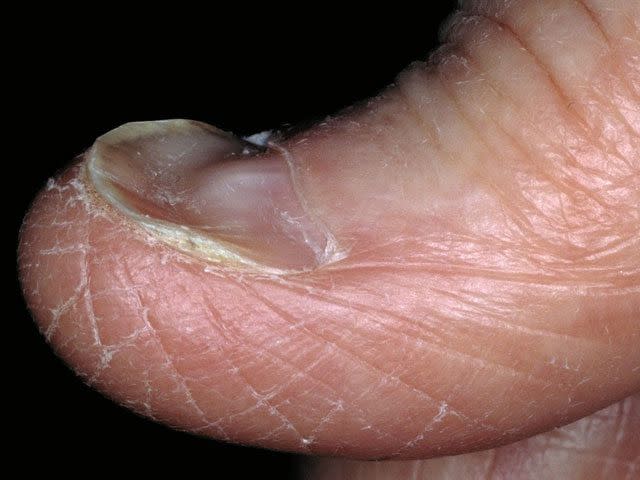
Reproduced with permission from © DermNet and © Raimo Suhonen dermnetnz.org 2023.
Koilonychia, or "spoon nails," is when nails are flattened and have depressions that make them look cupped or spoon-shaped. It may be caused by iron deficiency.
If you notice a spoon shape to your nails, talk to a healthcare provider about what might be causing it. You may need treatment for an iron deficiency.
Leukonychia (White Spots)
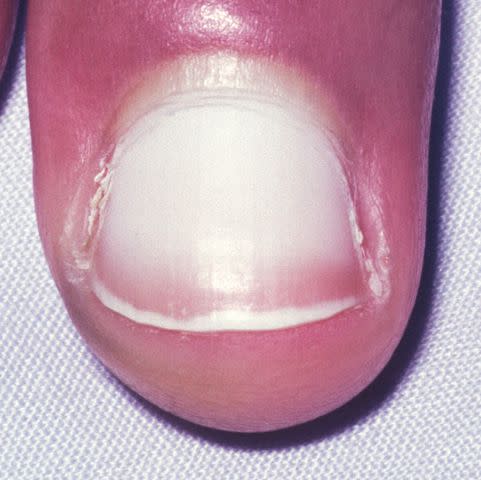
Reproduced with permission from © DermNet and © Dr Richard Ashton dermnetnz.org 2023
Leukonychia is when white spots or white streaks appear on the fingernails or toenails or when the whole nail turns white.
Causes of leukonychia are often medication- or disease-related but can also be a result of minor injuries, such as from nail-biting, banging the nail on something, or a manicure. There are different types of leukonychia, which are associated with different systemic (body-wide) illnesses.
If you notice white spots or whitening of your nails, talk to a healthcare provider or dermatologist. They can diagnose the type of leukonychia and recommend the next steps if an underlying condition is at play.
Mees' Lines
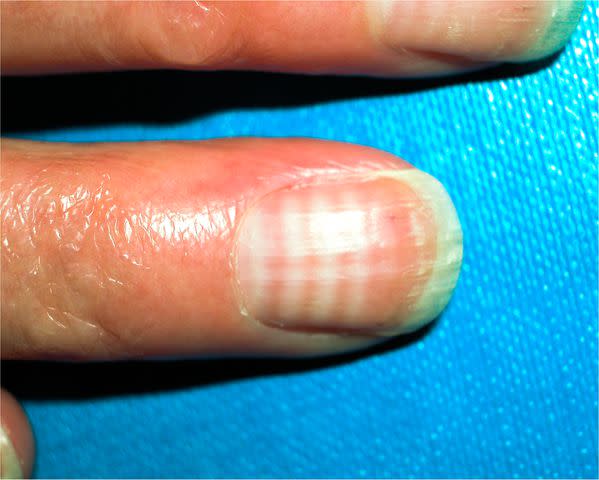
Reproduced with permission from © DermNet dermnetnz.org 2023.
Mees’ lines, also known as striate leukonychia or transverse leukonychia, are thin white bands that appear on the surface of the nail. Mees’ lines may be caused by damage to the nail. For example, Mees’ lines on the fingernails may be due to nail damage from a manicure.
If both the fingernails and toenails have Mees’ lines, talk to a healthcare provider. These could be a sign of an underlying medical issue, such as toxicity from certain substances like arsenic, though chemotherapy drugs are more often the cause.
Onycholysis
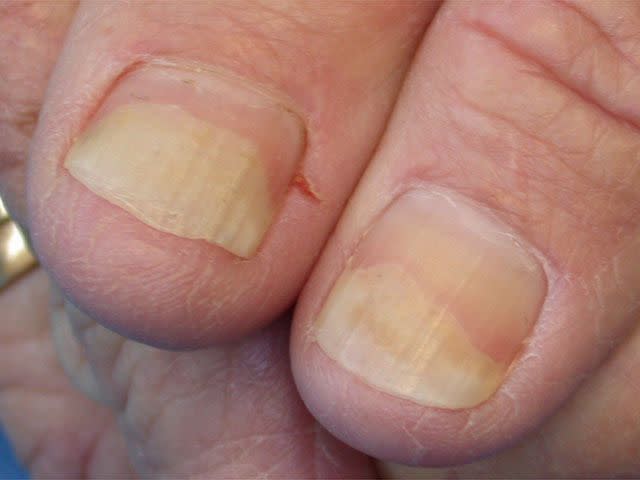
Reproduced with permission from © DermNet dermnetnz.org 2023
Onycholysis is when the top of the nail (nail plate) separates from the nail bed. When the nail lifts up and is no longer completely attached, that part of the nail appears white.
Onycholysis can be caused by psoriasis (an autoimmune skin condition), a fungal infection, or injury, such as from sharp objects used during a manicure or when cleaning under your nail.
If you’re not sure what caused your nail to lift, talk to a healthcare provider so that they can treat you for the underlying cause.
Pitting
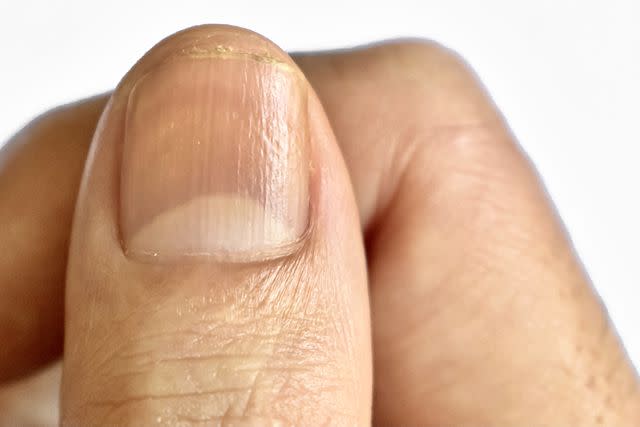
Zay Nyi Nyi / Getty Images
Pitting is when the nails have small depressions or tiny dents in them. Pitted nails may also crumble and sometimes loosen and fall off. Pitting is associated with systemic diseases, including psoriasis, alopecia areata, and atopic dermatitis.
A dermatologist can help you address these underlying diseases and develop a treatment plan to improve your nails and overall health.
Terry Nails
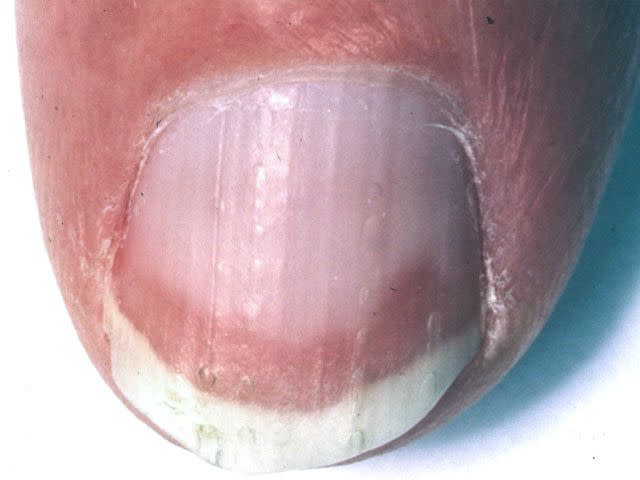
Reproduced with permission from © DermNet dermnetnz.org 2023.
Terry nails are a type of leukonychia where most of the nail is white and a thin dark line appears at the tip of the nail. Terry nails are linked to a variety of health conditions, including:
Heart failure
Zinc or iron deficiency
Hypoalbuminemia (not enough albumin protein)
Hyperthyroidism (too much thyroid hormone)
Diabetes
Protein-losing enteropathy (protein loss through the gastrointestinal tract)
Yellow Nail Syndrome
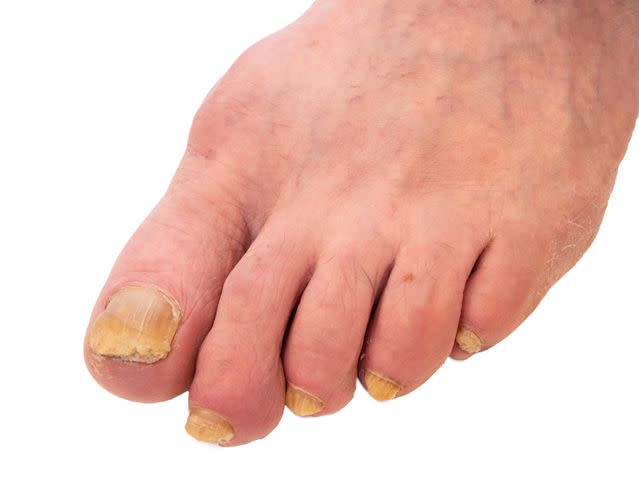
PabloUA / Getty Images
Yellow nail syndrome is a rare disorder mostly affecting older adults characterized by yellow, curved, and thick fingernails or toenails.
Yellow nails can be caused by rheumatoid arthritis, a serious infections, and lung disease; however, they can also be caused by wearing nail polish or smoking.
Some research has suggested yellow nail syndrome has a genetic component, meaning it may run in families.
If you have thick, yellow nails that stop growing, talk to a healthcare provider as this might be a sign of an underlying health condition.
How to Prevent Nail Abnormalities
Regularly checking your nails for changes or abnormalities is important, as nails can reflect overall health. In addition, taking care of your nails is important as they are part of your body. To help ensure your nails are healthy, consider the following recommendations:
Clip nails straight across with sharp nail scissors or clippers when the nails are soft, such as after a bath or shower.
Regularly trim toenails to keep them from repeatedly bumping into the front of shoes and causing trauma or injury.
Make sure your nails stay clean and dry, and use moisturizer on them to keep them flexible.
Avoid going barefoot in public places to reduce the risk of fungal infections.
Don’t dig into ingrown nails.
Don’t bite your nails or pull on hangnails—clip them with nail clippers or scissors instead.
When to Contact a Healthcare Provider
Some nail changes are normal and expected, such as a broken nail, whereas a healthcare provider should look at others. If you notice nail abnormalities that don’t go away or get worse, talk to a healthcare provider.
Although not all nail abnormalities are concerning, some are signs of an underlying health condition. A primary care provider may refer you to a dermatologist, who is trained in diagnosing and treating skin conditions, including those of the nails.
A healthcare provider may do a physical exam and other tests to determine the underlying cause of nail abnormalities and design a treatment plan accordingly.
Summary
Nail abnormalities are sometimes harmless, though some may indicate an underlying health condition. There are several types of nail abnormalities, each with underlying causes that may go unnoticed otherwise.
It’s important to take good care of your nails and check them regularly for changes. Talk to a healthcare provider if any changes persist or worsen so that you can get prompt treatment if needed.
Read the original article on Verywell Health.

